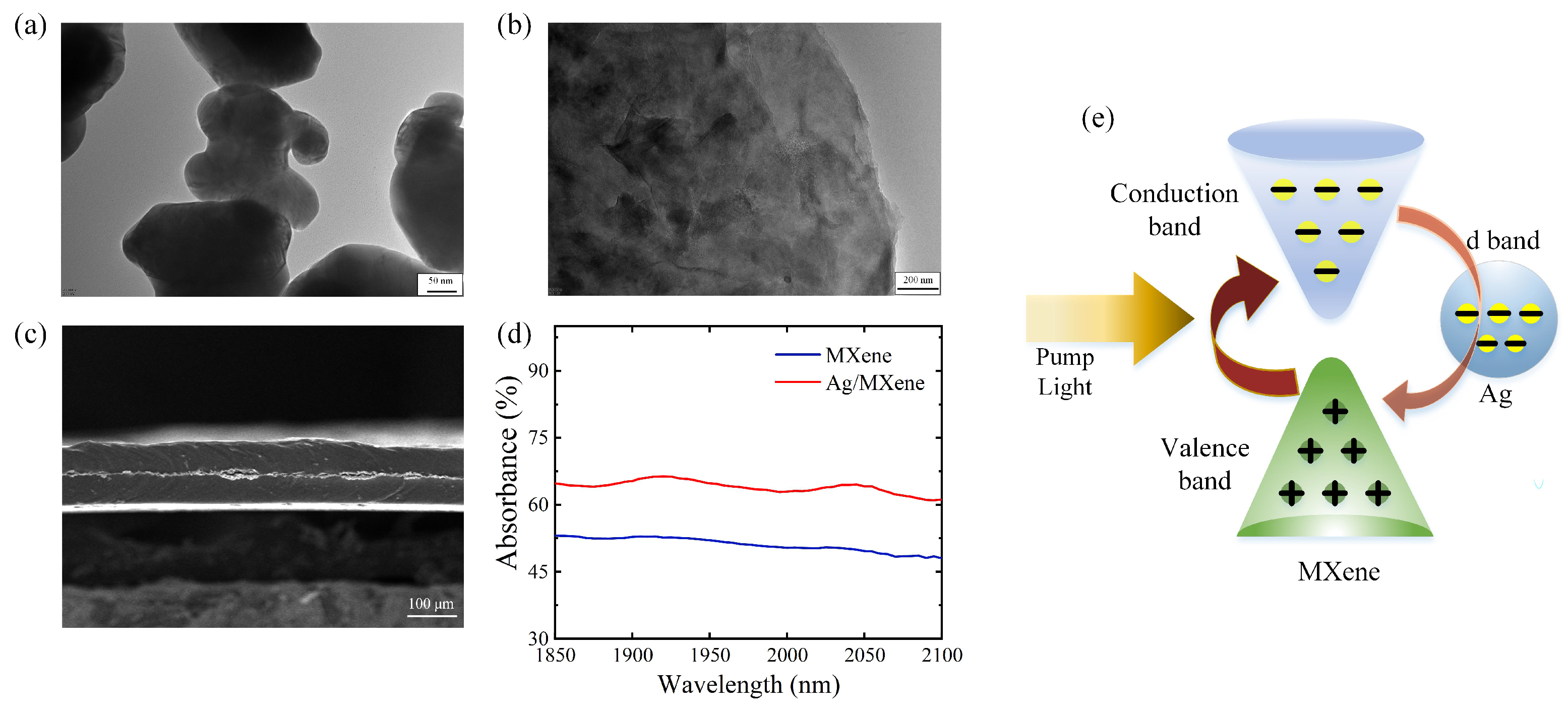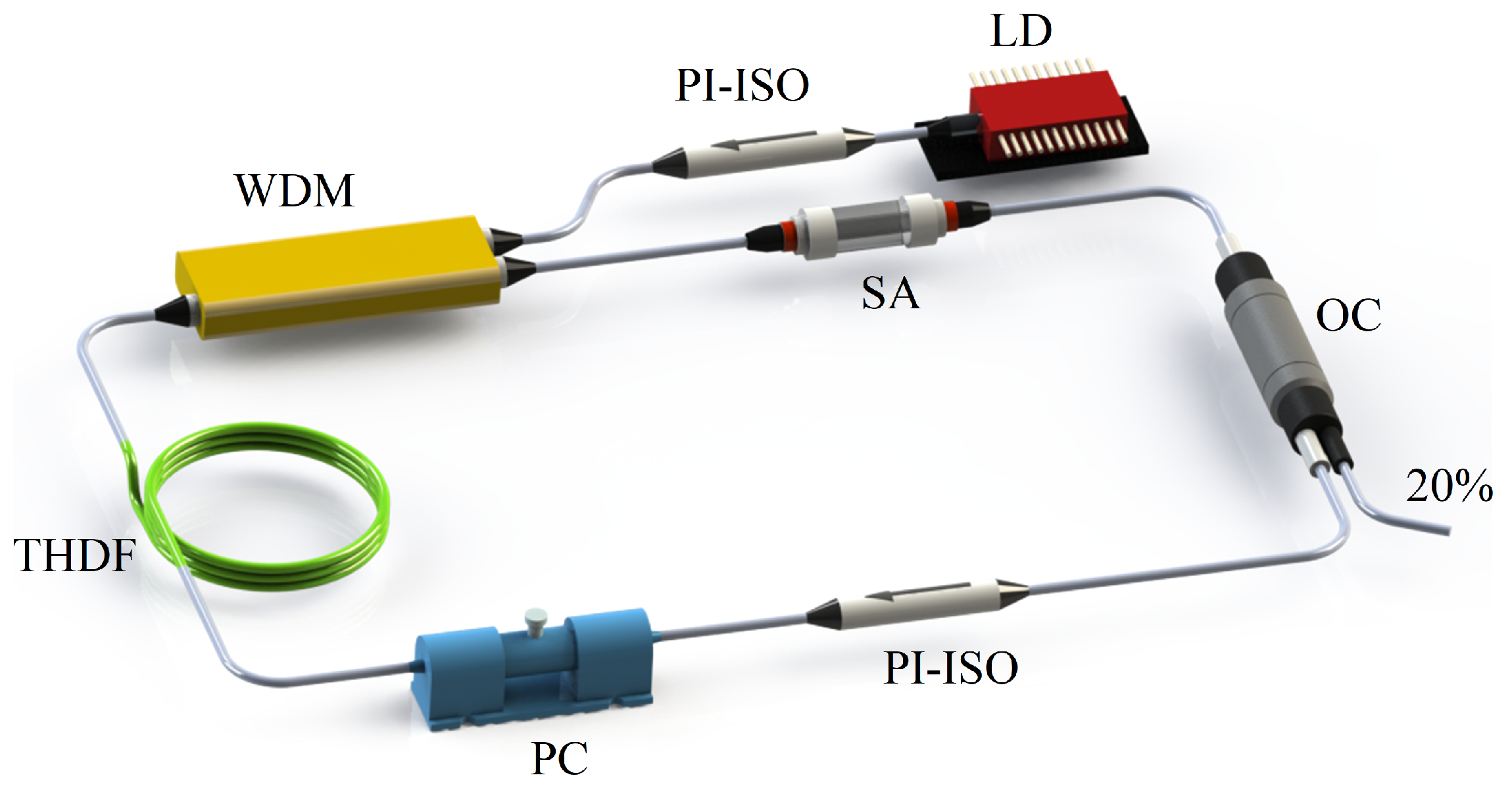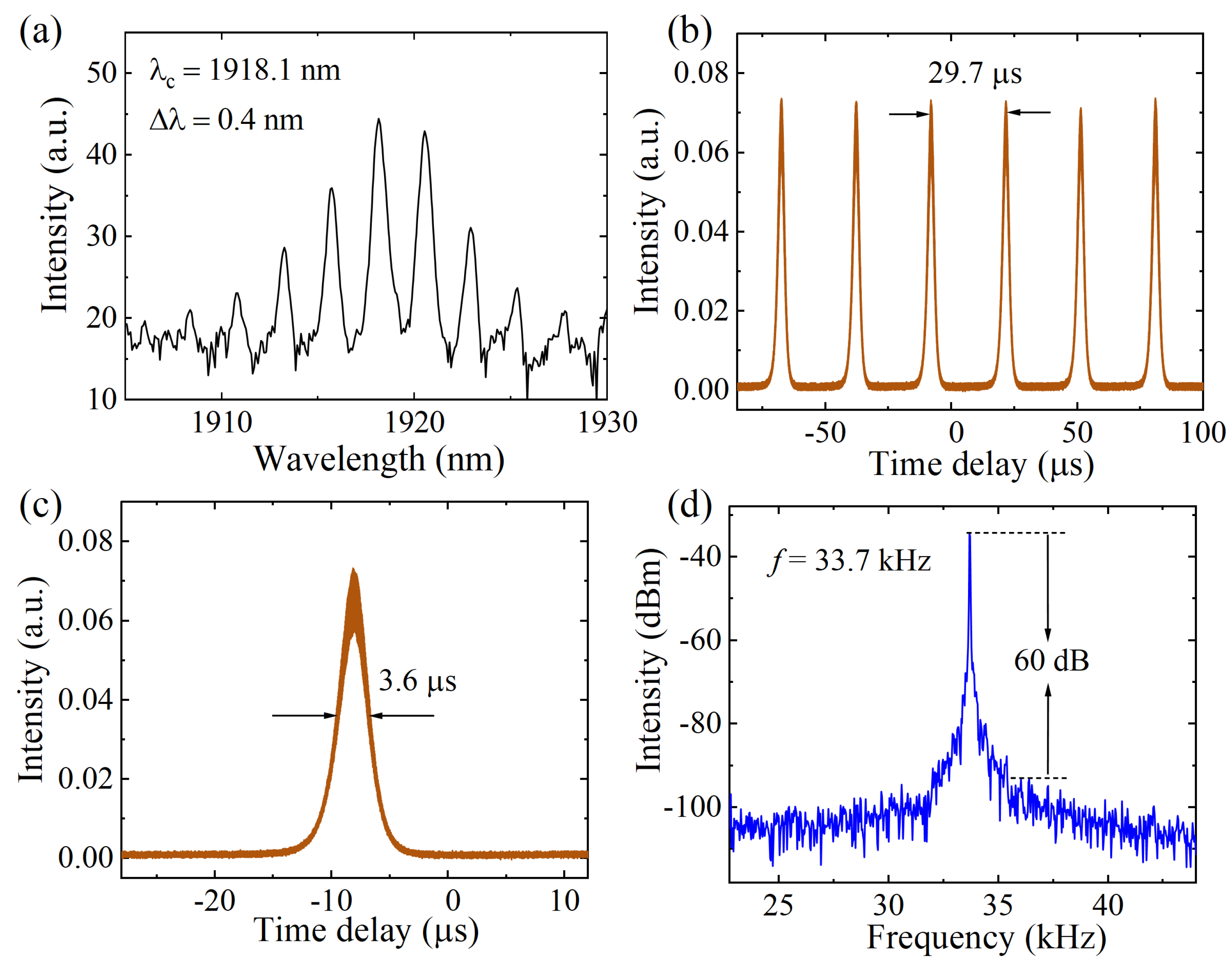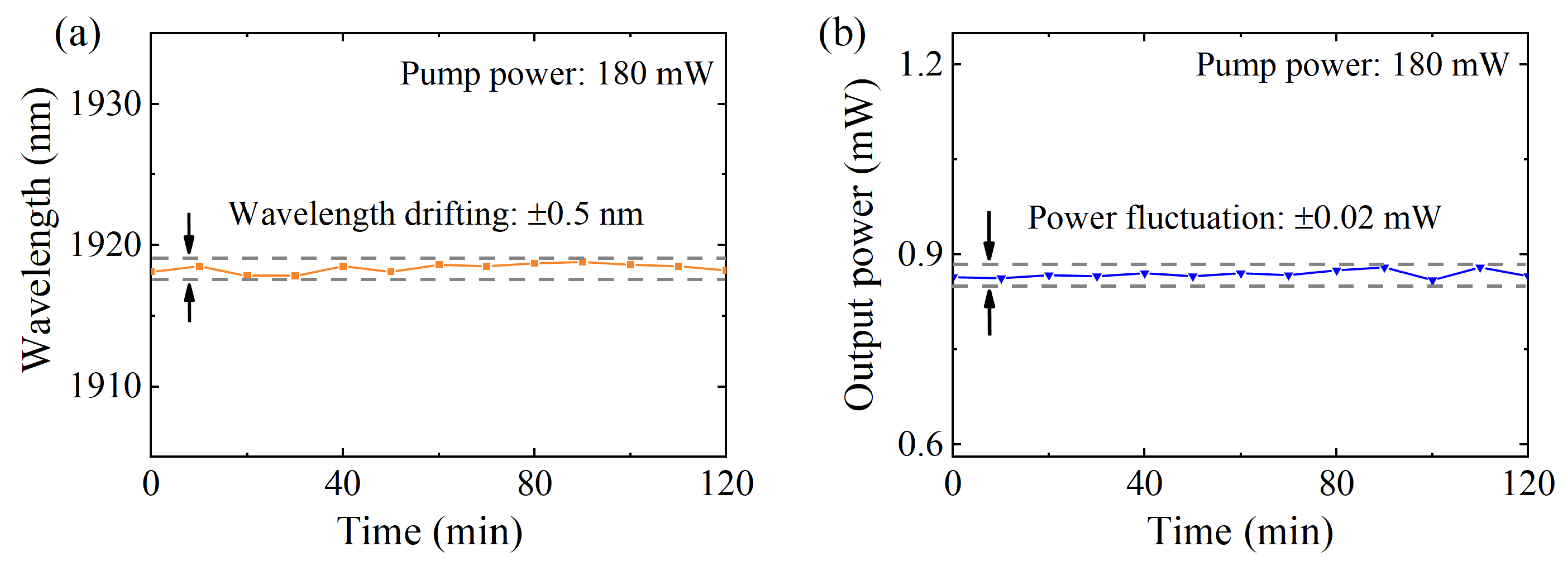Ag/MXene as Saturable Absorber for Tm:Ho Co-Doped Q-Switched Fiber Laser
Abstract
:1. Introduction
2. Experimental Methods
2.1. Properties of Ag/MXene Composite
2.2. Laser Setup
3. Results and Discussion
4. Conclusions
Author Contributions
Funding
Data Availability Statement
Conflicts of Interest
References
- Shi, W.; Fang, Q.; Zhu, X.; Norwood, R.A.; Peyghambarian, N. Fiber lasers and their applications. Appl. Opt. 2014, 53, 6554–6568. [Google Scholar] [CrossRef] [PubMed]
- Kurkov, A.; Sadovnikova, Y.E.; Marakulin, A.; Sholokhov, E. All fiber Er-Tm Q-switched laser. Laser Phys. Lett. 2010, 7, 795. [Google Scholar] [CrossRef]
- Gao, C.; Wang, L.; Gao, M.; Wang, Q.; Zhang, J.; Tang, D. Q-switched ceramic lasers for remote sensing. SPIE Newsroom 2014. [Google Scholar] [CrossRef]
- Ivanenko, M.; Fahimi-Weber, S.; Mitra, T.; Wierich, W.; Hering, P. Bone tissue ablation with sub-μs pulses of a Q-switch CO2 laser: Histological examination of thermal side effects. Lasers Med. Sci. 2002, 17, 258–264. [Google Scholar] [CrossRef] [PubMed]
- Zhang, C.; Qu, F.; Ou, P.; Sun, H.; He, S.; Fu, B. Recent advances and outlook in single-cavity dual comb lasers. Photonics 2023, 10, 221. [Google Scholar] [CrossRef]
- Zayhowski, J.J. Passively Q-switched Nd: YAG microchip lasers and applications. J. Alloys Compd. 2000, 303, 393–400. [Google Scholar] [CrossRef]
- Piao, Z.; Zeng, L.; Chen, Z.; Kim, C.S. Q-switched erbium-doped fiber laser at 1600 nm for photoacoustic imaging application. Appl. Phys. Lett. 2016, 108, 143701. [Google Scholar] [CrossRef] [PubMed]
- Dai, S.; Li, X.; Wu, D.; Nie, Q. Broad-spectrum and all-fiber passively Q-switched Tm-doped fiber laser based on SESAM. Optik 2018, 165, 195–199. [Google Scholar] [CrossRef]
- Liu, J.; Xu, J.; Wang, P. Graphene-based passively Q-switched 2 μm thulium-doped fiber laser. Opt. Commun. 2012, 285, 5319–5322. [Google Scholar] [CrossRef]
- Jung, M.; Koo, J.; Chang, Y.; Debnath, P.; Song, Y.; Lee, J. An all fiberized, 1.89-μm Q-switched laser employing carbon nanotube evanescent field interaction. Laser Phys. Lett. 2012, 9, 669. [Google Scholar] [CrossRef]
- Lyu, W.; An, J.; Lin, Y.; Qiu, P.; Wang, G.; Chao, J.; Fu, B. Fabrication and applications of heterostructure materials for broadband ultrafast photonics. Adv. Opt. Mater. 2023, 11, 2300124. [Google Scholar] [CrossRef]
- Zhao, X.; Jin, H.; Liu, J.; Chao, J.; Liu, T.; Zhang, H.; Wang, G.; Lyu, W.; Wageh, S.; Al-Hartomy, O.A.; et al. Integration and applications of nanomaterials for ultrafast photonics. Laser Photonics Rev. 2022, 16, 2200386. [Google Scholar] [CrossRef]
- Fu, B.; Hua, Y.; Xiao, X.; Zhu, H.; Sun, Z.; Yang, C. Broadband graphene saturable absorber for pulsed fiber lasers at 1, 1.5, and 2 μm. IEEE J. Sel. Top. Quantum Electron. 2014, 20, 411–415. [Google Scholar]
- Yang, H.; Fu, B.; Li, D.; Tian, Y.; Chen, Y.; Mattila, M.; Yong, Z.; Li, R.; Hassanien, A.; Yang, C.; et al. Broadband laser polarization control with aligned carbon nanotubes. Nanoscale 2015, 7, 11199–11205. [Google Scholar] [CrossRef] [PubMed]
- Yu, H.; Zheng, X.; Yin, K.; Cheng, X.; Jiang, T. Nanosecond passively Q-switched thulium/holmium-doped fiber laser based on black phosphorus nanoplatelets. Opt. Mater. Express 2016, 6, 603–609. [Google Scholar] [CrossRef]
- Muhammad, A.R.; Zakaria, R.; Ahmad, M.T.; Rahim, H.R.A.; Arof, H.; Harun, S.W. Q-switched thulium-doped fiber laser with pure titanium-film-based saturable absorber. Fiber Integr. Opt. 2019, 38, 137–147. [Google Scholar] [CrossRef]
- Al-Hiti, A.S.; Hassan, H.; Yasin, M.; Harun, S.W. Passively Q-switched 2 μm fiber laser with WO3 saturable absorber. Opt. Fiber Technol. 2023, 75, 103193. [Google Scholar] [CrossRef]
- Fu, B.; Sun, J.; Wang, C.; Shang, C.; Xu, L.; Li, J.; Zhang, H. MXenes: Synthesis, optical properties, and applications in ultrafast photonics. Small 2021, 17, 2006054. [Google Scholar] [CrossRef] [PubMed]
- Buntat, M.A.; Rosol, A.H.A.; Rusdi, M.F.M.; Latif, A.; Yasin, M.; Harun, S.W. Ti3C2Tx thin film as a saturable absorber for passively generating Q-switched pulses in thulium-doped fiber laser cavity. Nanosyst. Chem. Math. 2021, 12, 436–441. [Google Scholar] [CrossRef]
- Ahmad, H.; Albaqawi, H.S.; Ramli, R.; Samion, M.Z.; Yusoff, N.; Yi, C.W. Ti3C2 MXene as an optical modulator in a Thulium/Holmium-doped fiber laser. Opt. Laser Technol. 2022, 149, 107802. [Google Scholar] [CrossRef]
- Xie, H.; Li, P.; Shao, J.; Huang, H.; Chen, Y.; Jiang, Z.; Chu, P.K.; Yu, X.F. Electrostatic self-assembly of Ti3C2Tx MXene and gold Nanorods as an efficient surface-enhanced Raman scattering platform for reliable and high-sensitivity determination of organic pollutants. ACS Sens. 2019, 4, 2303–2310. [Google Scholar] [CrossRef]
- Yue, M.; Li, F.; Lu, N.; Yao, P.; Xue, T.; Liu, P. Synthesis of two-dimensional Ti3C2Tx/Au nanosheets with SERS performance. Appl. Opt. 2019, 58, 8290–8294. [Google Scholar] [CrossRef] [PubMed]
- Mu, H.; Lin, S.; Wang, Z.; Xiao, S.; Li, P.; Chen, Y.; Zhang, H.; Bao, H.; Lau, S.P.; Pan, C.; et al. Black phosphorus-polymer composites for pulsed lasers. Adv. Opt. Mater. 2015, 3, 1447–1453. [Google Scholar] [CrossRef]
- Hasan, T.; Sun, Z.; Wang, F.; Bonaccorso, F.; Tan, P.H.; Rozhin, A.G.; Ferrari, A.C. Nanotube-polymer composites for ultrafast photonics. Adv. Mater. 2009, 21, 3874–3899. [Google Scholar] [CrossRef]
- Ramlan, N.A.; Zakaria, R.; Zulkipli, N.; Jafry, A.A.; Kamarulzaman, R.; Kasim, N. Silver indium selenide composite as a saturable absorber for passive Q-switched and mode-locked pulsed generation in erbium-doped fiber laser. Optik 2023, 292, 171388. [Google Scholar] [CrossRef]
- Ahmad, H.; Samion, M.; Muhamad, A.; Sharbirin, A.; Ismail, M.F. Passively Q-switched thulium-doped fiber laser with silver-nanoparticle film as the saturable absorber for operation at 2.0 μm. Laser Phys. Lett. 2016, 13, 126201. [Google Scholar] [CrossRef]
- Lv, C.; Luo, H.; Cui, L.; Zhang, T.; Jia, Z.; Li, J.; Qin, W.; Qin, G. Silver nanowires with ultrabroadband plasmon response for ultrashort pulse fiber lasers. Adv. Photonics Res. 2022, 3, 2100184. [Google Scholar] [CrossRef]
- Jia, Y.; Pan, Y.; Wang, C.; Liu, C.; Shen, C.; Pan, C.; Guo, Z.; Liu, X. Flexible Ag microparticle/MXene-based film for energy harvesting. Nano-Micro Lett. 2021, 13, 201. [Google Scholar] [CrossRef] [PubMed]
- Humayun, M.; Zada, A.; Li, Z.; Xie, M.; Zhang, X.; Qu, Y.; Raziq, F.; Jing, L. Enhanced visible-light activities of porous BiFeO3 by coupling with nanocrystalline TiO2 and mechanism. Appl. Catal. B Environ. 2016, 180, 219–226. [Google Scholar] [CrossRef]
- Naguib, M.; Kurtoglu, M.; Presser, V.; Lu, J.; Niu, J.; Heon, M.; Hultman, L.; Gogotsi, Y.; Barsoum, M.W. Two-dimensional nanocrystals produced by exfoliation of Ti3AlC2. Adv. Mater. 2011, 37, 4248–4253. [Google Scholar] [CrossRef]
- Krutyakov, Y.A.; Kudrinskiy, A.A.; Olenin, A.Y.; Lisichkin, G.V. Synthesis and properties of silver nanoparticles: Advances and prospects. Russ. Chem. Rev. 2008, 77, 233. [Google Scholar] [CrossRef]
- Yu, Y.X. Prediction of mobility, enhanced storage capacity, and volume change during sodiation on interlayer-expanded functionalized Ti3C2 MXene anode materials for sodium-ion batteries. J. Phys. Chem. 2016, 120, 5288–5296. [Google Scholar] [CrossRef]
- Sharma, V.; Datta, D. Variation in the interface strength of silicon with surface engineered Ti3C2 MXenes. Phys. Chem. Chem. Phys. 2021, 23, 5540–5550. [Google Scholar] [CrossRef]
- Dweydari, A.; Mee, C. Work function measurements on (100) and (110) surfaces of silver. Phys. Status Solidi 1975, 27, 223–230. [Google Scholar] [CrossRef]
- Chelvayohan, M.; Mee, C. Work function measurements on (110), (100) and (111) surfaces of silver. J. Phys. Solid State Phys. 1982, 15, 2305. [Google Scholar] [CrossRef]
- Uda, M.; Nakamura, A.; Yamamoto, T.; Fujimoto, Y. Work function of polycrystalline Ag, Au and Al. J. Electron Spectrosc. Relat. Phenom. 1998, 88, 643–648. [Google Scholar] [CrossRef]
- Niu, H.J.; Yan, Y.; Jiang, S.; Liu, T.; Sun, T.; Zhou, W.; Guo, L.; Li, J. Interfaces Decrease the Alkaline Hydrogen-Evolution Kinetics Energy Barrier on NiCoP/Ti3C2Tx MXene. ACS Nano 2022, 16, 11049–11058. [Google Scholar] [CrossRef]
- Yang, C.; Qin, S.; Zuo, Y.; Shi, Y.; Bie, T.; Shao, M.; Yu, Y. Waveguide Schottky photodetector with tunable barrier based on Ti3C2Tx/p-Si van der Waals heterojunction. Nanophotonics 2021, 10, 4133–4139. [Google Scholar] [CrossRef]
- Zhao, F.; Wang, Y.; Kang, L. A density functional theory study on the performance of graphene and N-doped graphene supported Au3 cluster catalyst for acetylene hydrochlorination. Can. J. Chem. 2016, 94, 842–847. [Google Scholar] [CrossRef]
- Agresti, A.; Pazniak, A.; Pescetelli, S.; Di Vito, A.; Rossi, D.; Pecchia, A.; Auf der Maur, M.; Liedl, A.; Larciprete, R.; Kuznetsov, D.V.; et al. Titanium-carbide MXenes for work function and interface engineering in perovskite solar cells. Nat. Mater. 2019, 18, 1228–1234. [Google Scholar] [CrossRef]
- Ashton, M.; Hennig, R.G.; Sinnott, S.B. Computational characterization of lightweight multilayer MXene Li-ion battery anodes. Appl. Phys. Lett. 2016, 108, 023901. [Google Scholar] [CrossRef]
- Niyitanga, T.; Chaudhary, A.; Ahmad, K.; Kim, H. Titanium Carbide (Ti3C2Tx) MXene as Efficient Electron/Hole Transport Material for Perovskite Solar Cells and Electrode Material for Electrochemical Biosensors/Non-Biosensors Applications. Micromachines 2023, 14, 1907. [Google Scholar] [CrossRef] [PubMed]
- Yan, L.; Xu, Y.; Si, J.; Li, Y.; Hou, X. Enhanced optical nonlinearity of Mxene Ti3C2Tx nanosheets decorated with silver nanoparticles. Opt. Mater. Express 2021, 11, 1401–1409. [Google Scholar] [CrossRef]
- Taghinejad, M.; Cai, W. All-optical control of light in micro-and nanophotonics. ACS Photonics 2019, 6, 1082–1093. [Google Scholar] [CrossRef]
- Garmire, E. Resonant optical nonlinearities in semiconductors. IEEE J. Sel. Top. Quantum Electron. 2000, 6, 1094–1110. [Google Scholar] [CrossRef]
- Xu, X.; Yao, Y.; Zhao, X.; Chen, D. Multiple four-wave-mixing processes and their application to multiwavelength erbium-doped fiber lasers. J. Light. Technol. 2009, 27, 2876–2885. [Google Scholar]
- Al-Alimi, A.; Bakar, M.A.; Abas, A.; Alresheedi, M.; Abidin, N.Z.; Mahdi, M. Stable multiwavelength thulium fiber laser assisted by four wave mixing effect. Opt. Laser Technol. 2018, 106, 191–196. [Google Scholar] [CrossRef]
- Tanaka, S.; Somatomo, H.; Inamoto, K.; Takahashi, N. Triple wavelength SOA-based fiber ring laser for use in wavelength-division multiplexed FBG vibration sensor array. In Proceedings of the 19th International Conference on Optical Fibre Sensors, Perth, WA, Australia, 15–18 April 2008; Volume 7004, pp. 77–80. [Google Scholar]
- Abdhul Rahuman, M.A.; Kahatapitiya, N.S.; Amarakoon, V.N.; Wijenayake, U.; Silva, B.N.; Jeon, M.; Kim, J.; Ravichandran, N.K.; Wijesinghe, R.E. Recent technological progress of fiber-optical sensors for bio-mechatronics applications. Technologies 2023, 11, 157. [Google Scholar] [CrossRef]
- Kim, B.M.; Feit, M.D.; Rubenchik, A.M.; Joslin, E.J.; Celliers, P.M.; Eichler, J.; Da Silva, L.B. Influence of pulse duration on ultrashort laser pulse ablation of biological tissues. J. Biomed. Opt. 2001, 6, 332–338. [Google Scholar] [CrossRef]
- Lin, H.H.; Chang, C.W.; Huang, T.Y.; Tsao, S.L. A multi-channel multi-wavelength spectrum sliced light source for WDM free space broadcasting laser communication system. In Proceedings of the Free-Space Laser Communications V. SPIE, San Diego, CA, USA, 2–4 August 2005; Volume 5892, pp. 555–564. [Google Scholar]
- Qhumayo, S.; Martinez Manuel, R.; Kaboko, J. A Multi-Wavelength Erbium Doped Fiber Laser for Free Space Optical Communication Link; SATNAC: Skukuza, South Africa, 2012. [Google Scholar]
- Aso, O.; Tadakuma, M.; Namiki, S. Four-wave mixing in optical fibers and its applications. Furukawa Rev. 1999, 1, 63–68. [Google Scholar]
- Ahmad, H.; Reduan, S.A.; Sharbirin, A.S.; Ismail, M.F.; Zulkifli, M.Z. Q-switched thulium/holmium fiber laser with gallium selenide. Optik 2018, 175, 87–92. [Google Scholar] [CrossRef]
- Rahman, M.F.A.; Rusdi, M.F.M.; Lokman, M.Q.; Mahyuddin, M.B.H.; Latiff, A.A.; Rosol, A.H.A.; Dimyati, K.; Harun, S.W. Holmium oxide film as a saturable absorber for 2 μm Q-switched fiber laser. Chin. Phys. Lett. 2017, 34, 054201. [Google Scholar] [CrossRef]
- Luo, Z.; Li, Y.; Huang, Y.; Zhong, M.; Wan, X. Graphene mode-locked and Q-switched 2-μm Tm/Ho codoped fiber lasers using 1212-nm high-efficient pumping. Opt. Eng. 2016, 55, 081310. [Google Scholar] [CrossRef]
- Ahmad, M.; Muhammad, A.; Zakaria, R.; Ahmad, H.; Harun, S. Electron beam deposited silver (Ag) saturable absorber as passive Q-switcher in 1.5-and 2-micron fiber lasers. Optik 2020, 207, 164455. [Google Scholar] [CrossRef]
- Ahmad, H.; Sharbirin, A.S.; Muhamad, A.; Samion, M.Z.; Reduan, S.A.; Zulkifli, A.Z.; Ismail, M.F. Aluminized film as saturable absorber for generating passive Q-switched pulses in the two-micron region. J. Light. Technol. 2017, 35, 2470–2475. [Google Scholar] [CrossRef]
- Latiff, A.; Shamsudin, H.; Ahmad, H.; Harun, S. Q-switched thulium-doped fiber laser operating at 1940 nm region using a pencil-core as saturable absorber. J. Mod. Opt. 2016, 63, 783–787. [Google Scholar] [CrossRef]
- Taghinejad, M.; Xia, C.; Hrton, M.; Lee, K.T.; Kim, A.S.; Li, Q.; Guzelturk, B.; Kalousek, R.; Xu, F.; Cai, W.; et al. Determining hot-carrier transport dynamics from terahertz emission. Science 2023, 382, 299–305. [Google Scholar] [CrossRef] [PubMed]
- Liu, W.; Xu, Y.; He, L.; van der Laan, G.; Zhang, R.; Wang, K. Experimental observation of dual magnetic states in topological insulators. Sci. Adv. 2019, 5, eaav2088. [Google Scholar] [CrossRef] [PubMed]
- Sun, J.; Cheng, H.; Xu, L.; Fu, B.; Liu, X.; Zhang, H. Ag/MXene composite as a broadband nonlinear modulator for ultrafast photonics. ACS Photonics 2023, 10, 3133–3142. [Google Scholar] [CrossRef]
- Zhao, X.; Li, S.; Zhang, C.; Fu, B. MXene-based Q-switched fiber laser and application in laser thrombolysis. Opt. Fiber Technol. 2024, 84, 103763. [Google Scholar] [CrossRef]
- Sanderson, T.; Ume, C.; Jarzynski, J. A comparison of Q-switched and intensity modulated laser pulses for ultrasonic NDT. J. Nondestruct. Eval. 1998, 17, 199–208. [Google Scholar] [CrossRef]
- Zalkepali, N.U.H.H.; Awang, N.A.; Mahmud, N.N.H.E.N.; Abd Latif, A. Indium Tin Oxide-based Q-switched pulse fiber laser for sensing application. Opt. Contin. 2023, 2, 164–176. [Google Scholar] [CrossRef]
- Kim, B.; Kim, D.Y. Enhanced tissue ablation efficiency with a mid-infrared nonlinear frequency conversion laser system and tissue interaction monitoring using optical coherence tomography. Sensors 2016, 16, 598. [Google Scholar] [CrossRef] [PubMed]






| Material | Wavelength (nm) | Modulation Depth (%) | Pulse Width (s) | Repetition Rate (kHz) | SNR (dB) | Reference |
|---|---|---|---|---|---|---|
| Gallium selenide | 1986 | 7.1 | 6.9 | 22.9 | 42 | [54] |
| Holmium oxide | 1955 | / | 2.6 | 40 | 47 | [55] |
| Graphene | 1976 | / | 2 | 31.5 | 51 | [56] |
| Ag | 1928 | 3.2 | 4.8 | 28 | 33 | [57] |
| Aluminized film | ∼1948 | 3 | 5.5 | 37 | 34 | [58] |
| Pencil-core flakes | 1940 | 12.5 | 6.7 | 15 | / | [59] |
| Ag/MXene | 1918 | 14.9 | 3.6 | 33.7 | 60 | This work |
Disclaimer/Publisher’s Note: The statements, opinions and data contained in all publications are solely those of the individual author(s) and contributor(s) and not of MDPI and/or the editor(s). MDPI and/or the editor(s) disclaim responsibility for any injury to people or property resulting from any ideas, methods, instructions or products referred to in the content. |
© 2024 by the authors. Licensee MDPI, Basel, Switzerland. This article is an open access article distributed under the terms and conditions of the Creative Commons Attribution (CC BY) license (https://creativecommons.org/licenses/by/4.0/).
Share and Cite
Zhao, X.; Sun, J.; Wang, Y.; Wang, X.; Fu, B. Ag/MXene as Saturable Absorber for Tm:Ho Co-Doped Q-Switched Fiber Laser. Nanomaterials 2024, 14, 951. https://doi.org/10.3390/nano14110951
Zhao X, Sun J, Wang Y, Wang X, Fu B. Ag/MXene as Saturable Absorber for Tm:Ho Co-Doped Q-Switched Fiber Laser. Nanomaterials. 2024; 14(11):951. https://doi.org/10.3390/nano14110951
Chicago/Turabian StyleZhao, Xiaoli, Jingxuan Sun, Yachen Wang, Xiaogang Wang, and Bo Fu. 2024. "Ag/MXene as Saturable Absorber for Tm:Ho Co-Doped Q-Switched Fiber Laser" Nanomaterials 14, no. 11: 951. https://doi.org/10.3390/nano14110951






